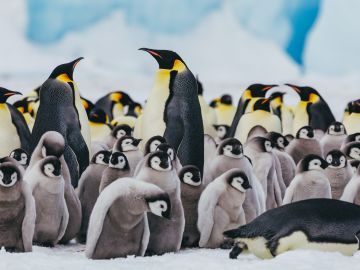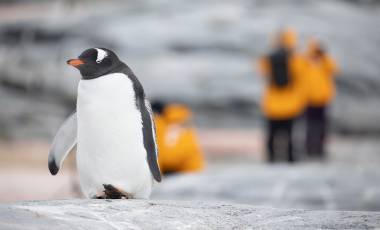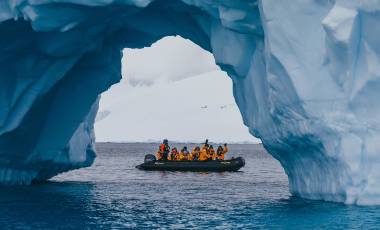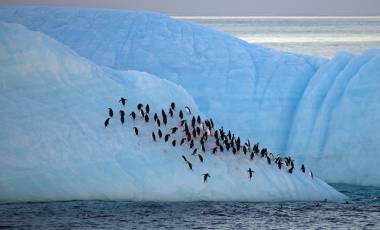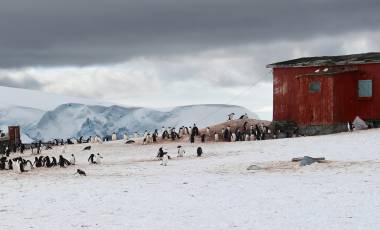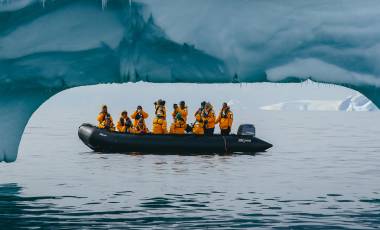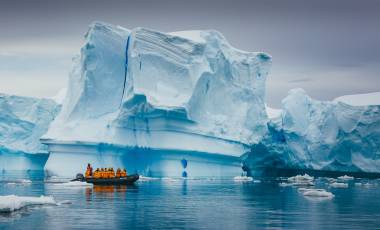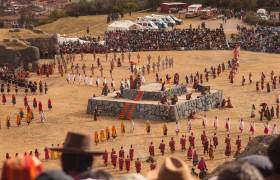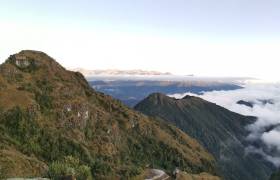An Antarctic expedition is a dream for many but doing so under the guidance of award-winning wildlife photographer and guide Paul Goldstein will invigorate your Antarctic journey to unparalleled heights – just ask the previous 30 charters he’s led. Our Snow Hill to the Peninsula: Shackleton’s Emperors with Paul Goldstein itinerary offers extraordinary opportunities to not only explore the rugged and remote wilderness of the Eastern peninsula but also capture its breathtaking beauty through your camera or video lens. Here are ten compelling reasons to book this peerless journey:

1. Visit The Staggeringly Beautiful Emperor Colony Of Snow Hill Island
Standing over a meter tall, emperor penguins are the largest of their species. Their striking black, white and orange plumage, coupled with their regal bearing, make them a captivating subject for any ornithologist or wildlife photographer.
As the name of the voyage suggests, this expedition visits Snow Hill Island, home to approximately 8,000 pairs of emperor penguins and their captivating tiny grey chicks as well as exploring the seldom-visited Eastern Antarctic Peninsula. It is one of the least visited places on earth.
One of the most common questions about this extraordinary expedition is: How many times can we visit the emperor penguin colony? The answer? As many times as nature allows. Paul says, “The Weddell Sea always provides challenges, particularly in late spring, but this is the only time to see the emperors with their families. As this is an extended departure (17 days not 12) the best weather can be identified as well as the optimum ice window in advance – so there is lots of flexibility here. Everyone (all staff as well) is keen for the most time at Snow Hill that nature permits, and nothing is stopping extra days if the weather allows.”

2. Photograph Emperor Penguin Chicks Huddled In Crèches
By the very end of October, when this voyage departs, emperor penguin chicks have only recently hatched, making it the most fertile time to visit. Observing these endearing birds and chicks in their remote and icy backyard is right up there with the finest avian experiences anywhere on the planet.
The Antarctic winter has just begun to release its icy grip, and the sea ice remains thick enough to support the long journey required to reach the colony. Here, you’ll find thousands of fluffy grey chicks who are either tucked between their parents’ feet or huddled in crèches for warmth, waiting for their next meal. With their wobbly steps and curious eyes, it’s an incredible opportunity for photographers to capture moments of pure innocence in the Antarctic. Paul comments, “But this is not a picnic for either birds – Antarctic skuas circle, preying on the weak or infirm, or indeed passengers as it is a grown-up one-mile yomp to the colony.”

3. Navigate Antarctica’s Most Spectacular Seas
This itinerary charts a course through Antarctica’s most impressive icescapes. From towering icebergs to expansive ice floes, every day presents fresh and spectacular scenery. This journey retraces sections of Sir Ernest Shackleton’s legendary expedition, through the fabled Eastern peninsula and Weddell Sea.
When it comes to the crossing itself Paul said, “The Drake Passage is perhaps the most famous stretch of water in the world. It can either be a lake or a shake but make no mistake the crossing is a significant maritime badge of honour. Fortunately, the Ultramarine is equipped with advanced stabilisers and boasts an impressive top speed, ensuring a smoother crossing. Shackleton managed to survive 600 nautical miles of these waters in the James Caird, your ‘accommodation’ is slightly less primitive.”

4. Experience A Bird’s Eye View Of Antarctica Via Helicopter
One of the most exhilarating parts of this expedition is the opportunity to explore Antarctica from the air, using the Ultramarine’s twin-engine helicopters. These aerial excursions provide unparalleled access and views to some of the continent’s most remote and captivating areas. Paul said, “Obviously they are employed to ferry passengers to the Snow Hill colony but the aerials over the Weddell’s massive grounded tabular bergs are pretty close to polar nirvana.”

5. With The Group Size Limited, You Maximise Time In The Most Remote Areas
The ship takes 199 guests, but this departure is limited to 125 maximum. In such a remote and fragile environment, fewer people mean greater flexibility, more opportunities for close wildlife encounters, and minimal impact on the landscape. Most importantly it means longer excursions ashore when in the Weddell Sea and a quicker operation of disembarking passengers from the ship. With weather frequently capricious at best, this number limit is a huge advantage.
Unlike larger ships where overcrowding can limit time on the ice, this expedition prioritises as much time as possible ashore and at the emperor rookery (as much as weather permits). This also means you get to spend more time with your guide and photographer, Paul. You’ll enjoy, dedicated coaching in the field and not just from him, many of the staff are accomplished photographers.

6. Quark’s Outstanding Pedigree
In 2004, it was Quark that actually found the Snow Hill emperor colony. Previously you had to travel for many weeks through the Ross Sea to find them. This is closer, in a more exciting and spectacular area and you know, with this polar pedigree, you are in good hands. You have a spanking new state-of-the-art ship, twin-engine choppers and superb facilities on board as well as a magnificent restaurant that are all the pride of the fleet.

7. Not Since The Endurance Has There Been A More Experienced Team In The Weddell
Ultramarine’s team of naturalists, seasoned polar guides, and photographers are among the most knowledgeable in the industry. They may not be called Worsley, Crean, McNeish or Ernest Henry but their passion for Antarctica, coupled with their extensive field experience, means that travellers benefit from extensive insights into the region’s wildlife, ecology and history.
These experts provide invaluable context and storytelling that bring the frozen landscape to life. Obviously, we want you out on deck, ashore, on Zodiacs or at the rookery wherever possible, but when it is not possible or during the journey South and returning across the Drake, we have experts on board to keep you entertained and invigorated on every aspect of this remote wilderness with lectures covering topics from ecology to pinnipeds.

8. No Guide Or Photographer Works Harder Than Paul Goldstein
When asked if you need to be a good photographer for this trip, Paul explains, “Absolutely not. 600 mm state-of-the-art lens and slick mirrorless camera to a smartphone: all will be catered for.”
Paul has made a successful career in guiding and photography and his ethic of supremely long hours in the most fertile and potent faunal hotspots has paid deep dividends across six continents, and it will be no different here. Keen photographers are going to seriously improve their game no end under his guidance just as much as beginners. His hands-on approach and commitment to his craft ensure that travellers receive invaluable mentorship that allows them to hone their photographic skills. He is also an accomplished raconteur who has regaled audiences for many years with his imagery, outspoken views and indeed humour. There are reasons why he has such a large following.

9. Sail Past The World’s Tallest Icebergs
The Weddell Sea is famed for its gigantic icebergs, the largest on the planet. Navigating through this frozen seascape, with towering Gaudi-esque icebergs casting shimmering reflections on the midnight blue waters is a surreal experience. Many will be adorned with early season Adélies and chinstrap penguins.
Reaching Snow Hill in November is always a maritime challenge, which makes it all the more rewarding. Paul remarked, “If it was easy everyone would be doing it, and its currency would drop. As it is, very few ever get the chance to do this.”

10. Enjoy Antarctica In Early Season
October marks the beginning of Antarctic spring with longer daylight hours and a landscape that’s still untouched by the later-season melt. Many people on board may have seen the countless thousands of King penguins on the charcoal volcanic beaches of South Georgia but nothing can prepare you for the emperors, framed and furnished by pristine icebergs and a sparkling ice platform. Whether it is a pair of binoculars, a smartphone or many millimetres of telephoto, this colony is unlike anywhere on Earth. This expedition will, appropriately, be unlike any other.
Snow Hill to the Peninsula: Shackleton’s Emperors with Paul Goldstein is much more than a regular Antarctic cruise; it’s a once-in-a-lifetime ‘expedition’ that takes you into the most remote regions of Antarctica. Whether you’re an adventure seeker, avid photographer or wildlife enthusiast, this extraordinary journey is one you should seriously consider. Paul will tell anyone who listens, and many who won’t, that this will be the best journey in the world this autumn. The whole area bewitches him, just as it did the heroic explorers over a hundred years ago. So, jump on board and find out why.
Photos courtesy of Paul Goldstein and David Merron
